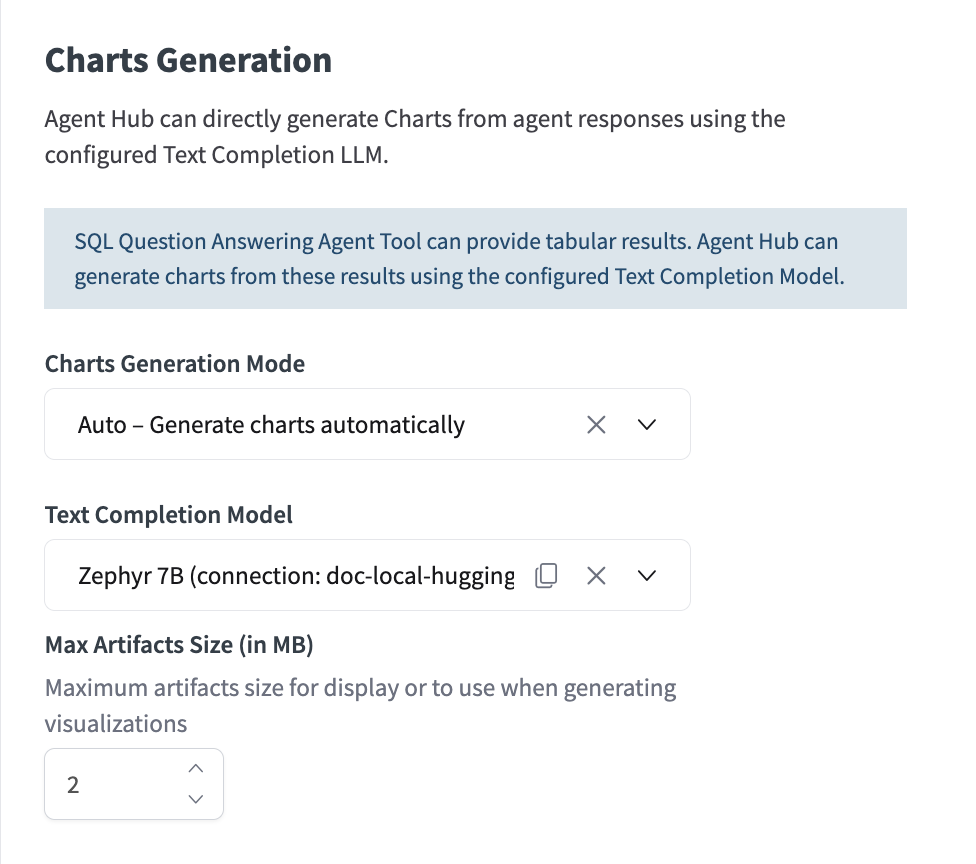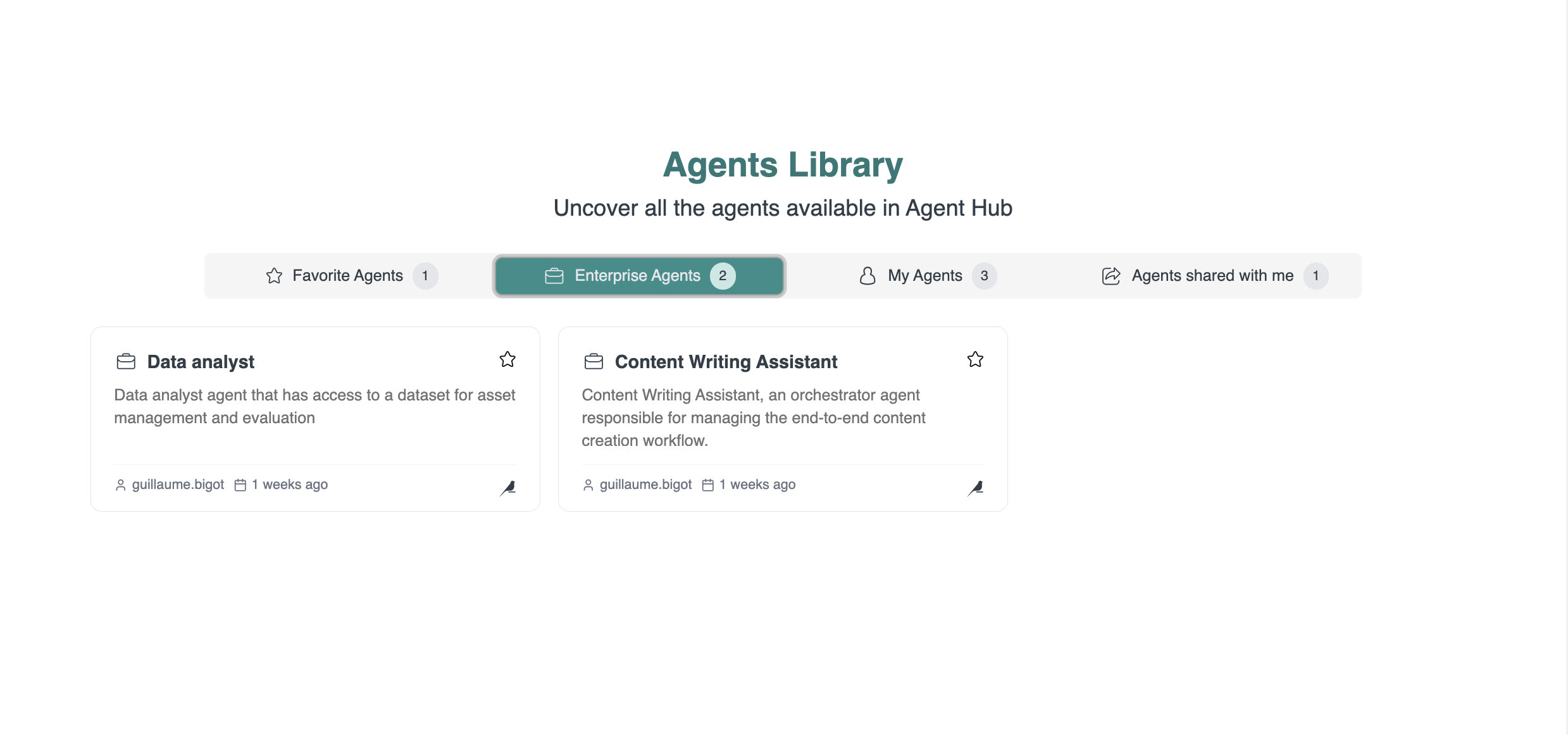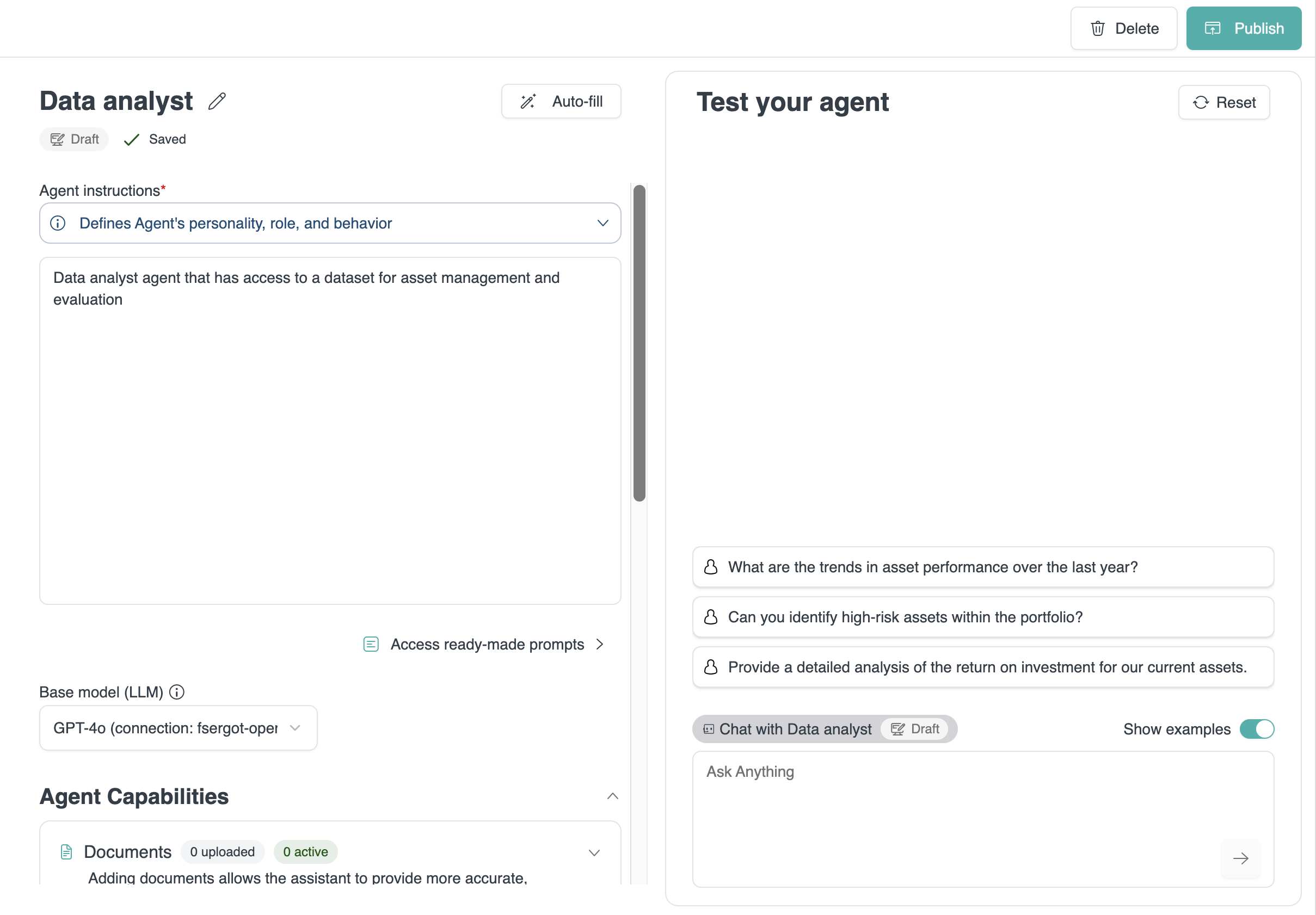Agent Hub¶
Overview¶
Agent Hub is the central portal for organizations to distribute enterprise-level agents, manage access, and empower users to build their own custom agents.
Agent Hub is a Dataiku plugin providing: a visual webapp, an export recipe and a custom dataset.
It allows users to access a library of AI agents and leverage a single agent or orchestrate multiple agents simultaneously through a unified chat interface.
Key Features
- Centralized Agent Library: Access from your browser a curated list of purpose-built agents built and selected by your AI experts and SMEs.
- Multi-Agent Orchestration: Chat with multiple agents in a single conversation. The Hub intelligently routes queries to the most relevant agent(s).
- User-Built Agents: Empower end-users to quickly create their own “My Agents” for personal productivity.
- Governance and Control: Configure which enterprise agents, LLMs, and tools are available within a Hub, ensuring control over usage.
- Response Transparency: View detailed sources, activities, and downloads for each agent response to understand how an answer was generated.
For more information, see also the following article in the Knowledge Base.
Getting Access¶
To use Agent Hub, a Dataiku instance administrator must first install the Agent Hub plugin from the plugin store. The administrator also needs to set up the associated code environment.
Once installed, the Agent Hub template becomes available as a Visual Webapp that can be created within any Dataiku project.
Configuration¶
Requirements¶
To successfully set up and use an Agent Hub, the following prerequisites are necessary:
Dataiku Version:
Dataiku 14.2or later. The Last Dataiku version is always the best choice to leverage the latest plugin capabilities fully.User Profile: You must have a
Full Designerprofile with rights to create projects and impersonate certain user groups to build and configure an Agent Hub with all functionalities. Users withAI ConsumerorAI Accessprofiles can use a Hub that has been shared with them.LLM Connections: A connection to at least one Generative AI model that supports tool calling and one that supports embedding. These are configured by an administrator in
Administration > Connections.
Initial Setup¶
Agent Hub is created as a visual webapp within a Dataiku project.
From your project, navigate to the Code menu and select Webapps.
Click
+ New Webappand chooseVisual webapp.Select the
Agent Hubtemplate from the list.
Note
While you can create Agent Hub webapp in the same project as your agents, it is recommended to create it in a dedicated project. This simplifies access management and oversight.
Backend Settings¶
Once the webapp has been created, you can select the execution settings from the Edit tab.
Auto-start backend: Check this box to ensure the Hub is running automatically.Number of processes: 0Container: SelectNone - Use backend to execute.
Webapp Settings¶
Once execution settings have been selected, all of the webapp settings are directly configured in the webapp by the admin.
Users with “write” access to the project holding the Agent Hub web application will have access to these settings. Users with read access won’t.
Core Settings¶
Agent Hub has one mandatory LLM connection required to function.
Agent Hub LLM: Select a text completion model. This model will be used across Agent Hub, particularly to orchestrate agents i.e. decide which agent to call in a multi-agent conversation. It is recommended to use a model that supports tool calling.Optional Instructions: You can optionally add a system prompt that will be used by the LLM when orchestrating agents.
Enterprise Agents¶
This section allows you to add pre-built, governed agents to the Hub.
Click on
Add Agent(s)and underSelect project, search for and select the Dataiku project(s) containing the agents you want to include.Amongst the list displayed, choose the specific agents/augmented LLMs to add.
- For each agent, you can configure the following:
Name: A user-friendly display name.Description (Mandatory): A detailed description of the agent’s capabilities and purpose. This is used by Agent Hub’s orchestrating LLM to understand when to call this agent. It is displayed to the end user in the Agent Library to describe the capabilities of the agent.Example questions: Sample questions that demonstrate how to use the agent.Additional instructions: Instructions that will be added to the Enterprise Agent’s system prompt.
My Agents¶
Configure the settings for user-created agents.
Enable My Agents: Toggle this option to allow users to create their own agents within the Hub.LLMs: Select at least one model that users can leverage when creating their own “My Agents”.Embedding Model: Select at least one model for embedding documents uploaded by users for their “My Agents”.File System Connection: Choose a connection where documents uploaded by users will be stored. This connection must allow the creation of managed folders.Folder where My Agents will be created: Optionally specify a managed folder where user agents will be stored.Number of documents to retrieve: Maximum number of document chunks to retrieve for context.Managed Tools: Select tools that users can pick for their agents. These can both be shared tools from other projects or tools instanciated in the project.Enable prompt library: Allow users to access a set of predefined prompts defined in thePrompt Library.Enable groups restriction for sharing: Limit sharing of My Agents to DSS groups to which the user belongs. Additionally, the admin can choose to exclude specific groups from sharing.
Note
My Agent sharing: Assuming three users and their groups.
If user A belongs to groups 1 and 2, user B belongs to groups 2 and 3, and user C belongs to group 4.
If this setting is disabled [Default]: A can share its My Agents with users B and C.
If this setting is enabled:
A can only share them with user B.
If, in addition, group 2 is added to the
List of groups that users may not share with, A can no longer share agents with users B and C.
Prompt Library¶
The admin can customize the prompts that are available to build My Agents in the Prompt Library. This includes:
Enabling/disabling Dataiku provided prompts
Adding company specific prompts
Prompts are organized by categories (corresponding to business domains like Manufacturing, Retail, Corporate functions…) or by tags (free text).
Charts Generation¶
Agent Hub can directly generate Charts from agent responses using the configured Text Completion LLM.
Charts Generation Mode:Select
None - Disable charts generationif this functionality is not needed. Else, charts will be generated using SQL artefacts of agents.Select
On Demand - Let end users generate charts, lets users decide when to generate charts and what type.Select
Auto - Generate charts automatically, automatically generates charts whenever the agent’s response includes SQL artefacts. The text completion model automatically chooses the type of graph based on the user query.
Text Completion Model: Choose an LLM connection to power chart generation if it is enabled.

Upload in Conversation¶
When the option Enable Document Upload is enabled by the admin, users can upload documents (PDF, JPG, PNG, PPTX, DOCX, TXT) in chat to enrich conversation context.
This requires setting up a managed folder where uploaded files will be stored.
There are two extraction modes admins choose from:
Using pages as screenshots
Pages of PDF, PPTX and DOCX files are screenshotted and passed as is to the multimodal LLM (the selected LLM needs to support multimodal inputs). In this mode, a maximum number of images that can be uploaded per conversation must be defined. If this maximum is reached, images are passed on to the multimodal LLM but only text is extracted from documents (PDF, PPTX and DOCX files).
Extracting text
In this mode, text is extracted from PDF, PPTX, DOCX files. Inline images in these documents can be processed with:
- OCR:
This identifies the characters in the inline image and converts it to text
Best for documents that don’t hold significant visual information (i.e. receipts)
- VLM:
Can “understand” visual elements, output is a textual description of the image. When queried, the LLM only uses the textual description generated, not the actual screenshot as in the first mode.
Best for photos, complex diagrams, charts, or screenshots of user interfaces where context/visual understanding matters.
It’s important to note that each and every image (including icons, logos, etc.) within the uploaded document are processed by the VLM, which can be very resource-intensive.
This requires DSS 14.3+
Not processed: This may result in information loss
User Experience¶
In the User Experience tab, the admin can configure end-user interface settings.
- Interface Settings:
Smart mode: Enable intelligent features and suggestions (e.g. Auto-fill of all missing fields of My Agent’s using the agent’s system prompt).Allow users to disable agents: Enabling this setting allows users to directly engage with an LLM. In this mode, their query is directly passed on to the head LLM and no agents are involved in generating the answer. The answer relies 100% on the LLM’s capabilities. If you want to completely disable direct interaction with LLMs, make sure to disableUpload in Conversation.
Conversation Starters: define queries and selection of linked agent(s) displayed on homepage.
Setting up integrations with Stories and Traces Explorer¶
Traces explorer¶
On top of in-app traces of tool/agent calls, comprehensive trace can be viewed using the integration with Trace Explorer. To use this integration, you must:
Ensure that the
Traces Explorerplugin is installed on your Dataiku instance.Create a Trace Explorer webapp in a project and give read access to relevant user groups.
In Administration > Settings > LLM Mesh, set the default Trace Explorer webapp to the one you just created.
The button to navigate to Trace Explorer will then appear in See details > Activities.
Stories¶
When looking to generate quick visualizations from data, users can leverage in-chat chart generation. For more complex data storytelling, users can navigate to Stories for analyses in visual slides that support quality decision-making. To enable this, you must:
Ensure that you have a Workspace correctly set up with the datasets you want to use.
In Admin Settings > Enterprise Agents, toggle
Allow users to create Insights in Dataiku Storiesand select the workspace where the stories will be created.
Navigating to Stories will automatically be available in the chat interface when the agent response includes SQL artefacts.
Note
Dataiku Stories is not available in all Dataiku licenses. You may need to reach out to your Dataiku Account Manager or Customer Success Manager
Building tools that integrate with Agent Hub¶
You can build custom tools that can be used by agents within Agent Hub.
Display Sources¶
If you want your agent data sources or references to be displayed in the “Sources” tab, you must provide this information into the additionalInformation field of their tool calls.
{
"toolCallDescription": "Revenue Analysis",
"items": [
{
"type": "INFO",
"textSnippet": "Analyzing sales data for Q3..."
},
{
"type": "GENERATED_SQL_QUERY",
"performedQuery": "SELECT date, revenue FROM sales WHERE quarter = 'Q3'"
},
{
"type": "RECORDS",
"records": {
"columns": ["date", "revenue"],
"data": [
["2023-07-01", 100],
["2023-07-02", 120]
]
}
}
]
}
Then you will need to tag each type of item used.
Tag to Use |
Display Text in “Sources” Tab |
|---|---|
|
Document |
|
Document |
|
Records |
|
Generated SQL Query |
|
Code Snippet |
|
Image |
|
Info |
Note
If you send a custom string (e.g., API_RESPONSE), the UI will display the raw string “API_RESPONSE” instead of a polished label.
Generate graphs¶
If you want your tool to return data that can be used to generate charts in the chat interface, you must return an artifact of type RECORDS.
{
def _create_record_payload(df):
return {
"type": "RECORDS", # Critical: tells UI to treat this as chartable data
"records": {
"columns": df.columns.to_list(), # List of string headers
"data": df.values.tolist() # List of lists (rows)
}
}
}
Downloadable Files¶
To make files generated by your tool downloadable directly in the UI, you need to return an artifact of type RECORDS.
If a single table is returned, it will generate a .csv file. If multiple tables are returned, they will be zipped into a single .zip file.
Using Agent Hub¶
Agent Library¶
The Agent Hub interface organizes all available agents into four categories:
Enterprise Agents: Governed agents distributed by designers for wide use.
My Agents: Agents you have created for your own productivity tasks.
Agents Shared with Me: “My Agents” that other users have shared with you.
Favorite Agents: Any agent you have marked with a star for quick access.

Conversations with Agents¶
You can start a conversation from the homepage or by selecting an agent. The Hub’s orchestrator manages the conversation based on the agent(s) selected.
Single agent: The query is passed directly to the selected agent.
Multiple agents: The Hub’s orchestrating LLM evaluates which agent is best suited to answer the query and calls it. Users can manually add or remove agents during the conversation.
No agent selected: The orchestrating LLM evaluates all available agents and selects the most relevant one(s) to answer the query.
All conversations are saved in the left panel, where you can rename, delete, or revisit them.
Building “My Agents”¶
Users with the appropriate permissions can create their own agents directly within the Hub.
Click
Create new agent.Provide detailed
Agent instructionsin the prompt window or use a template from thePrompt library.Under
Agent Capabilities, uploadDocumentsto provide the agent with specific knowledge. Dataiku automatically embeds these documents. AddToolsto let the agent perform actions or access external services.Manually fill or use the
Autofillbutton to generate anAgent Overview, to provide an agent description and optionally some example queries.Test your agent in the chat window and click
Publishwhen you are satisfied with its performance.

Understanding Responses¶
Agent Hub allows you to inspect how an agent generated its response.
Click the See details button below any response to open a panel with three tabs:
Sources: References to the documents, datasets, or other knowledge sources used by the agent.
Activities: A log of which agents and tools were called by the Hub and what actions they performed.
Downloads: Download any files generated by the agent.
Monitoring and Quality checks¶
Extracting Agent Hub’s logs¶
Once Agent Hub is set up and in production, administrators can extract Agent Hub’s logs to monitor usage and evaluate Enterprise Agents.
To do that, admin can either use a recipe that extracts Agent Hub’s raw database or create a virtual dataset on the relevant database tables.
The recipe to export data from AH to datasets
In the flow, click on Add item > Recipe > Generative AI > Agent Hub.
In the recipe, the admin can choose the project, the Agent Hub webapp instance, and the tables he wants to export. These are mapped out to the output datasets.
Given the potentially important size of artifacts, the admin can choose to keep them compressed.
A scenario can be run regularly to sync the data.
Creating a virtual dataset
A second option is to create a virtual dataset: Add item > Connect or Create > Generative AI > Agent Hub.
This reads a single table from an Agent Hub Webapp internal database, effectively creating a virtual dataset that can then be synced in the flow, and used just like the previous extracted datasets. Virtual datasets make requests to the Agent Hub’s internal database each time it is accessed - this can potentially be expensive.
Monitoring¶
Once the database is extracted, a dashboard can then be easily created atop these datasets to monitor Agent Hub activity more deeply. Furthermore, a monitoring dashboard is provided out-of-the-box in Agent Hub, including usage activity and user feedback, broken down by agents.
Quality checks¶
The extracted datasets include conversations and traces, that can be used to perform custom quality checks of the agents exposed through Agent Hub.
Security and Permissions¶
About DSS permissions¶
DSS project permissions are handled as follows:
DSS uses a groups-based model to allow users to perform actions through it.
The basic principle is that users are added to groups, and groups have permissions on each project.
On top of that, it is possible to:
Define per-user permissions on projects.
Share webapps into workspaces that have their own set of user/group permissions.
Agent Hub permissions¶
To share an Agent Hub with end-users, you must first grant them the necessary project permissions. There are different ways to do this:
Grant end-users access to the Enterprise Agents
Give end-users or their user groups
Read project contentpermissions on the Dataiku project(s) that contain the enterprise agents.Add the Agent to the list of authorized objects in the
Project securitysettings and grantRead dashboardspermission to end-users or their user group to the project hosting the agent.
Note
If a user isn’t granted read access to an Enterprise agent, the agent will not appear in his agent library. Calls to the agent and tools are made using the identity of the user running the backend.
Grant end-users access to the Agent Hub webapp:
Give end-users read access to the project hosting the Agent Hub application.
Share the Agent Hub webapp within a workspace that the end-users have access to.
Add the Agent Hub webapp to the list of authorized objects in the
Project securitysettings.
Warning
While it is not mandatory to be an instance administrator to create and configure an Agent Hub application, for full functionality the webapp backends requires being run as a Full designer allowed to create projects and that can impersonate other groups.
User Access Profiles¶
A user’s access level and capabilities within Agent Hub are determined by their Dataiku profile.
AI Access: Can use agents but cannot build them.
AI Consumers: Can use, build and share My Agents.
Full Designer: All previous capabilities, plus can build, configure, and manage Agent Hubs.